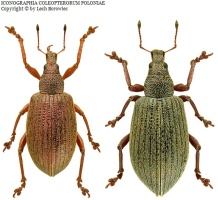Підтримуємо Вільну Україну
 We Support Free Ukraine
We Support Free Ukraine

Biodiversity Map
Taxa

-
Arthropodaphylum
Click to switch
to select orders
and filters > -
Hexapodasubphylum
Click to switch
to select orders
and filters > -
Insectaclass
Click to switch
to select orders
and filters > -
Coleopteraorder
Click to set
as the main taxon
and as a base
← of the left panel > -
Polyphagasuborder
Click to set
as the main taxon
and as a base
← of the left panel > -
Cucujiformiaseries
Click to set
as the main taxon
and as a base
← of the left panel > -
Curculionoideasuperfamily
Click to set
as the main taxon
and as a base
← of the left panel > -
Curculionidaefamily
Click to set
as the main taxon
and as a base
← of the left panel > -
Entiminaesubfamily
Click to set
as the main taxon
and as a base
← of the left panel > -
Polydrusinitribe
Click to set
as the main taxon
and as a base
← of the left panel > -
Polydrususgenus
Click to set
as the main taxon
and as a base
← of the left panel > -
Eudipnussubgenus
Click to set
as the main taxon
and as a base
← of the left panel >
species:
Polydrusus (Eudipnus) mollis
PL
YES
name status: valid name
BioMap ID: 1046686
taxon code: 5090
taxonomy checked: YES
Data on distribution in Poland

Statistics
- Records: 290
- Publications: 113
- Collections: 14
- Publication authors: 77
- Illustrations (iconography): 1
- Photos (specimen/observation): 1
Taxon description
Gatunek rozprzestrzeniony głównie w środkowej-i północnej części Europy, na południe sięgający po środkowe Włochy i Półwysep Bałkański, w Fennoskandii docierający do koła podbiegunowego; notowany ponadto z Syberii. W Polsce występuje pospolicie od Bałtyku po Sudety i Karpaty. Zamieszkuje w jasnych lasach liściastych, na nasłonecznionych zboczach i pobrzeżach lasu, w ogrodach owocowych i żywopłotach oraz na miejscach ruderalnych. Pojaw postaci dojrzałych przypada na kwiecień-lipiec. Żerują one na różnych krzewach liściastych i drzewach, zwłaszcza dębach, grabach, bukach, lipach, głogach i leszczynie. Gatunek notowany jako szkodnik drzew owocowych, głównie jabłoni.
Illustrations
... browse
 Polydrusus
Polydrususmollis
Photos
... browse
 Polydrusus
Polydrususmollis
External data sources
- Ostatnie rekordy
-
1112806
 ⊡
⊡ Curculionidae: Polydrusus mollis, PL, Podkarpacie, Beskid Wschodni, Stasiówka, UTM EA33, 2010, leg. A. Trzeciak
Curculionidae: Polydrusus mollis, PL, Podkarpacie, Beskid Wschodni, Stasiówka, UTM EA33, 2010, leg. A. Trzeciak -
1100110
 ×
× Curculionidae: Polydrusus mollis, PL, Ndl. Lidzbark, Branica, 1939, leg. A. Gottwald, coll. IBL, Zakład Ochrony Lasu, Sękocin: Gottwald
Curculionidae: Polydrusus mollis, PL, Ndl. Lidzbark, Branica, 1939, leg. A. Gottwald, coll. IBL, Zakład Ochrony Lasu, Sękocin: Gottwald -
1098944
 ⊡
⊡ Curculionidae: Polydrusus mollis, PL, Podlasie, Ruchna ad Węgrów, UTM ED70, 2009, leg. R. Plewa, coll. IBL, Zakład Ochrony Lasu, Sękocin: Gottwald
Curculionidae: Polydrusus mollis, PL, Podlasie, Ruchna ad Węgrów, UTM ED70, 2009, leg. R. Plewa, coll. IBL, Zakład Ochrony Lasu, Sękocin: Gottwald -
1098943
 ×
× Curculionidae: Polydrusus mollis, PL, Wyrzysk, Nakło, leg. A. Gottwald, coll. IBL, Zakład Ochrony Lasu, Sękocin: Gottwald
Curculionidae: Polydrusus mollis, PL, Wyrzysk, Nakło, leg. A. Gottwald, coll. IBL, Zakład Ochrony Lasu, Sękocin: Gottwald -
1098942
 ×
× Curculionidae: Polydrusus mollis, UA, Tarnopol, Łuczka, 1927, leg. A. Gottwald, coll. IBL, Zakład Ochrony Lasu, Sękocin: Gottwald
Curculionidae: Polydrusus mollis, UA, Tarnopol, Łuczka, 1927, leg. A. Gottwald, coll. IBL, Zakład Ochrony Lasu, Sękocin: Gottwald -
1098941
 ×
× Curculionidae: Polydrusus mollis, UA, Brzeżany, Gadzia Góra, 1928, leg. A. Gottwald, coll. IBL, Zakład Ochrony Lasu, Sękocin: Gottwald
Curculionidae: Polydrusus mollis, UA, Brzeżany, Gadzia Góra, 1928, leg. A. Gottwald, coll. IBL, Zakład Ochrony Lasu, Sękocin: Gottwald -
1098940
 ×
× Curculionidae: Polydrusus mollis, PL, Ndl. Dębowo, 1939, leg. A. Gottwald, coll. IBL, Zakład Ochrony Lasu, Sękocin: Gottwald
Curculionidae: Polydrusus mollis, PL, Ndl. Dębowo, 1939, leg. A. Gottwald, coll. IBL, Zakład Ochrony Lasu, Sękocin: Gottwald -
1098939
 ×
× Curculionidae: Polydrusus mollis, PL, Ndl. Dębowo, 1939, leg. A. Gottwald, coll. IBL, Zakład Ochrony Lasu, Sękocin: Gottwald
Curculionidae: Polydrusus mollis, PL, Ndl. Dębowo, 1939, leg. A. Gottwald, coll. IBL, Zakład Ochrony Lasu, Sękocin: Gottwald -
1042118
 ×
× Curculionidae: Polydrusus mollis, PL, Gorce, Grywałd, 1981, leg. S. Knutelski
Curculionidae: Polydrusus mollis, PL, Gorce, Grywałd, 1981, leg. S. Knutelski -
993889
 ×
× Curculionidae: Polydrusus mollis, coll. MiIZ PAN: Tenenbaum Sz.
Curculionidae: Polydrusus mollis, coll. MiIZ PAN: Tenenbaum Sz. - ... more
- Powiązane publikacje
-
Mazur M.A. 2011c. Weevils (Coleoptera: Curculionoidea) of the Stobrawski Landscape Park. Pol. Pismo Ent., 80(2):321-342.
 full text
full text Show records
Show records -
Mazur M.A. 2008c. Materiały do znajomości ryjkowców (Coleoptera: Apionidae, Curculionidae bez Scolytinae, Rhynchitidae) polskiej części Sudetów i Beskidów Zachodnich. Przyroda Sudetów, 11:73-76.
 Show records
Show records -
Sprick P., Floren A. 2007. Canopy leaf beetles and weevils in the Białowieża and Borecka Forests in Poland (Col., Chrysomeloidea, Curculionoidea). Pol. Pismo Ent., 76:75-100.
 Show records
Show records -
Ruta R. 2007. Chrząszcze (Insecta: Coleoptera) kserotermicznych wzgórz Byszewickich w Dolinie Noteci. Nowy Pam. Fizjogr., 5:49-107.
 Show records
Show records -
Maciejowski W. 2007. Wpływ cech środowiska przyrodniczego na rozmieszczenie wybranych grup chrząszczy (Coleoptera) w południowej części Wyżyny Krakowsko-Częstochowskiej. Wydawnictwo Uniwersytetu Jagiellońskiego. 177 pp.
 Show records
Show records - ... more
- Powiązane zbiory
-
IOR
 Show records
Show records -
ISEZ PAN
 Show records
Show records -
MiIZ PAN: Tenenbaum Sz.
 Show records
Show records -
Muz. Górnośląskie, Bytom: Mączyński
 Show records
Show records -
Muz. Tatrzańskie w Zakopanem
 Show records
Show records - ... more
- Wykaz powiązanych pozycji
-
Curculionoidea of Poland
 Show records
Show records -
Weevils of the Tatra Mts.
 Show records
Show records





